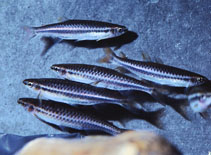| Family: |
Lebiasinidae (Pencilfishes), subfamily: Lebiasininae |
| Max. size: |
6.14 cm SL (male/unsexed) |
| Environment: |
pelagic; freshwater |
| Distribution: |
South America: Mazaruni River, Guyana. |
| Diagnosis: |
Dorsal spines (total): 2-2; Dorsal soft rays (total): 8-8; Anal soft rays: 9-10. Elongated body (greatest depth 4.60-5.45 in SL) with a narrow caudal peduncle; symmetrical caudal fin and a dorsal fin far backward. Transverse scales from dorsal to pelvic, 6 or 6.5; predorsal scales 15.5 or 16. Mouth somewhat superior with a short maxilla (apparent length 4.5-5.5 in HL), not quite reaching the level of the eye's front margin. Eyes relatively large. A longitudinal black band surmounted by a light line, from opercle to base of middle caudal rays (Ref. 47610). |
| Biology: |
A shy species (probably the most timorous pencil-fish species), living mainly on the surface and hidden, when possible, under a floating leaf or other hiding possibility. Swims actively, in a fitful manner, the moving of the pectorals is alternative, not symmetric. In captivity, accepts all foods, including dry ones, but only on the surface, neglecting what falls on the bottom. No peculiar nocturnal coloration; no direct courtship was yet observed, only short hunts against each other (within and between sexes) without real fights (Ref. 47610). |
| IUCN Red List Status: |
Vulnerable (VU); Date assessed: 31 December 2020 (B1ab(iii,v)+2ab(iii,v)) Ref. (130435)
|
| Threat to humans: |
harmless |
Source and more info: www.fishbase.org. For personal, classroom, and other internal use only. Not for publication.

